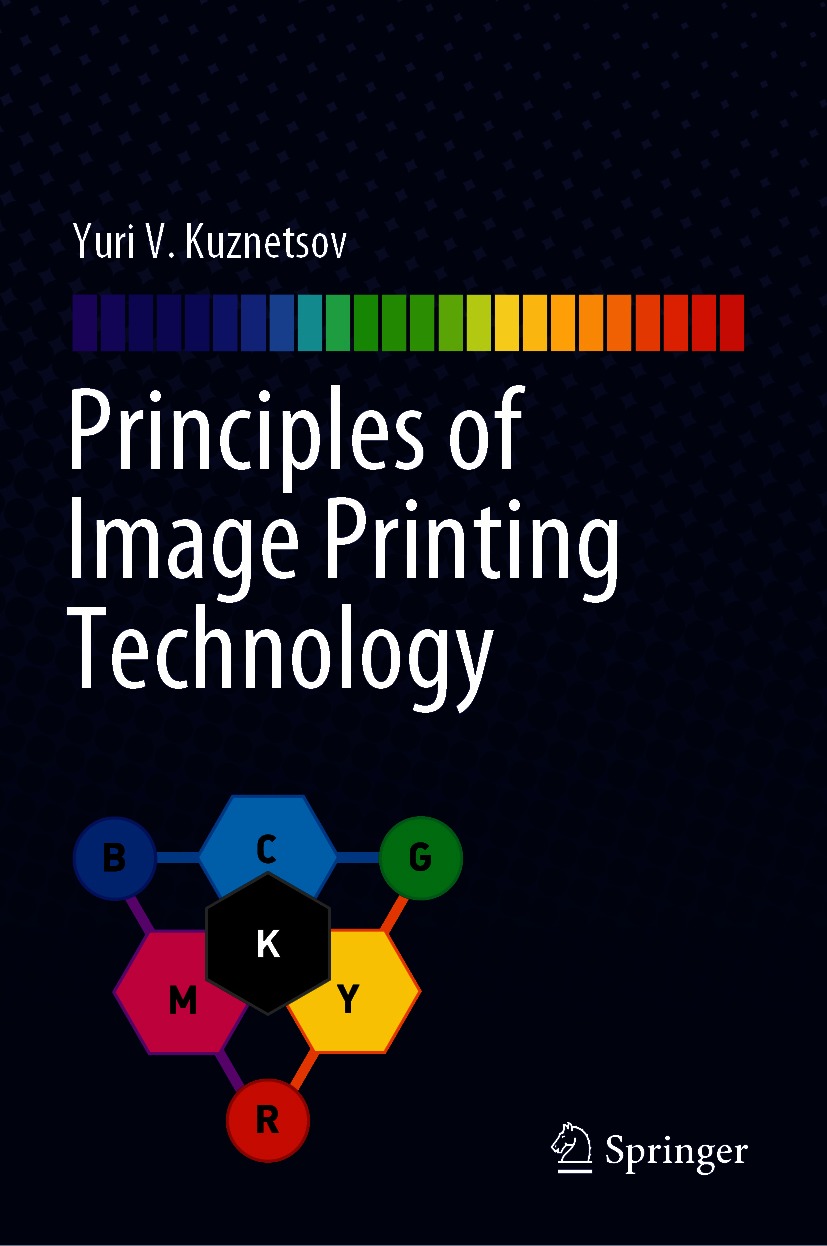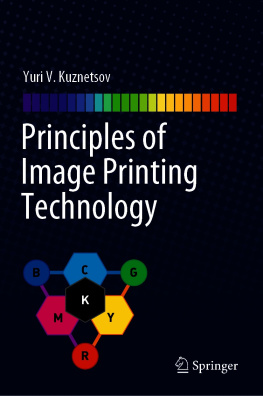Yuri V. Kuznetsov - Principles of Image Printing Technology
Here you can read online Yuri V. Kuznetsov - Principles of Image Printing Technology full text of the book (entire story) in english for free. Download pdf and epub, get meaning, cover and reviews about this ebook. publisher: Springer International Publishing, genre: Computer. Description of the work, (preface) as well as reviews are available. Best literature library LitArk.com created for fans of good reading and offers a wide selection of genres:
Romance novel
Science fiction
Adventure
Detective
Science
History
Home and family
Prose
Art
Politics
Computer
Non-fiction
Religion
Business
Children
Humor
Choose a favorite category and find really read worthwhile books. Enjoy immersion in the world of imagination, feel the emotions of the characters or learn something new for yourself, make an fascinating discovery.
- Book:Principles of Image Printing Technology
- Author:
- Publisher:Springer International Publishing
- Genre:
- Rating:4 / 5
- Favourites:Add to favourites
- Your mark:
- 80
- 1
- 2
- 3
- 4
- 5
Principles of Image Printing Technology: summary, description and annotation
We offer to read an annotation, description, summary or preface (depends on what the author of the book "Principles of Image Printing Technology" wrote himself). If you haven't found the necessary information about the book — write in the comments, we will try to find it.
Principles of Image Printing Technology — read online for free the complete book (whole text) full work
Below is the text of the book, divided by pages. System saving the place of the last page read, allows you to conveniently read the book "Principles of Image Printing Technology" online for free, without having to search again every time where you left off. Put a bookmark, and you can go to the page where you finished reading at any time.
Font size:
Interval:
Bookmark:


This Springer imprint is published by the registered company Springer Nature Switzerland AG
The registered company address is: Gewerbestrasse 11, 6330 Cham, Switzerland
For many years printing technology was mostly considered as specialized material processing routine leaning, in general, upon various sections of chemistry, physics, and photography. At the same time, the informational nature of a print had always appealed it to cognitive and aesthetic perception of a customer. While the other information technologies have appeared of modern precise knowledge, the printing industry accumulates the skills and experiences of graphic data processing which were generated over the centuries, i.e. much earlier than the term IT had come in use. So, the current IT era accentuates such nature of printing raw material and that of its final product.
Nevertheless, the physicochemical and mechanical component isnt even partially reduced in graphic techniques knowledge of today. Unlike other ITs, the output data has to be materialized here as a hard copy on a very different kind of print stock and with the use of steadily growing variety of equipment, consumables, and processes.
The other challenge of graphic technology qualification is in embracing the whole spectra of applications. The average headcount in this industry doesnt exceed 15, and there is hardly room in a company for more than one specialist with higher education. That, in turn, presents an obstacle to specialization which would focus just on a certain kind of printing method or product, as well as on prepress, press, or postpress.
So, there is a need to combine ever-growing physicochemical component with the electronic data processing issues within the unified educational paradigm.
The author was able to successfully solve this problem in this English version of the book, significantly updated in relation to its previous editions. Material is disclosed on the basis of the latest researches and his own long-term experience in lecturing the related courses of university program and developments in image encoding for printing during his 20 years of heading the Graphic Technology Department in the North-West Institute of Printing in St. Petersburg.
Contrary to the user manuals and other textbooks, the content isnt tied to the particular software or hardware use but elucidates the goals and ideas of image signal transforms, physical and colorimetric meaning of its digital values at each step of processing. It doesnt try to teach printing but explains the process thereof helping to improve its performance. In this and some other relations the book has no analogies.
Readers can find the questioning of and following explanation for some key technology issues, which are omitted or just superficially concerned in other sources, such as: the optimal choice of print settings on a press; ruling value, geometry and orientation of a halftone screen; functions of the black ink in multicolor printing; approaches in setting and realization the reproduction intents; methodology of the halftone print definition and sharpness estimation; and more.
Principles of Image Printing Technology will be very useful for students and for a wide range of print media researchers and professionals.
Printing technology can be thought of as a communication channel with a certain bandwidth and noise level. From such a point of view, the printing process, especially the digital one, appears as a specialized peripheral unit of a computing network. This book covers the prepress process and especially its screening stage, with an emphasis on optimal graphic data encoding procedures performed under specific criteria to provide mutual conformity between the properties of a data source (original image), channel (printing process) and receiver (Human Visual System). Along with the basics of image theory and digitization, special attention is given to the systematic analysis of important issues concerning plate making, and the specifics of visual data and color perception.
The impetus for publishing this book was a look at the amazingly fast developments in illustrative printing over the last few decades, reflected by the growing number of scientific publications and patents. This book provides a systematic and logical explanation of the illustrative printing fundamentals on which these rapid developments are based, and will hopefully help readers understand in depth the theory behind the existing printing approaches and technical solutions, and foresee their further development.
The book begins with a retrospective analysis of development in reproduction technology, covering the transition from manual engraving to photomechanics, and in turn, to modern electronic and digital techniques. Next, the fundamental differences between visual data transmission (reproduction) and data processing in cybernetics and machine graphics are covered, and the basic parameters of images as well as variation in their functional transformation are analyzed. The third and fourth chapters describe the characteristics of halftone printing alongside the methods to convert an original image into a print copy image with a discrete binary structure. The fifth chapter reports on a wide range of electronic reproduction tools while the sixth chapter explains spatial sampling, quantization, and digital encoding of the image signal these tools use. Chapters are devoted, respectively, to the processing of fine details, gradation, and dimensional conversion of images.
Font size:
Interval:
Bookmark:
Similar books «Principles of Image Printing Technology»
Look at similar books to Principles of Image Printing Technology. We have selected literature similar in name and meaning in the hope of providing readers with more options to find new, interesting, not yet read works.
Discussion, reviews of the book Principles of Image Printing Technology and just readers' own opinions. Leave your comments, write what you think about the work, its meaning or the main characters. Specify what exactly you liked and what you didn't like, and why you think so.









